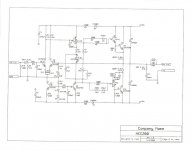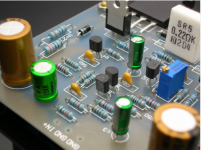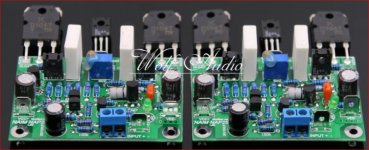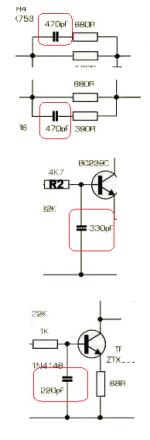The only components i will re-solder are outputs and mica capacitors.
I am sorry for double posting, but i meant that MICA capacitors and OUTPUT transistors will be pulled and re-used.
We got very nice soldering stations at work to do the job fast and without stressing the components.
What are you using mica capacitors for?
Maybe DIYaudio should design a definitive Naim clone with parts selection and select-on-test guide and PCBs.
Maybe DIYaudio should design a definitive Naim clone with parts selection and select-on-test guide and PCBs.
Maybe DIYaudio should design a definitive Naim clone with parts selection and select-on-test guide and PCBs.
Some official standardized part selection would be nice.
MICA is a ceramic, but more stable... and avaible in small values for VAS as a cob and in parallel with the feedback resistor network.
They are robust and can be used many times before scrapping.
Never tried a 39-56pf polystyrene.. but
Source:
OEM Polystyrene Capacitors | Hifi Collective
NCC200 and its clones do use ceramics, also a NAP200 clones.
Low cost is not true but the last spec is on spot
I really don't know whether it is better or not with polystyrene as Cob, sonically.
Source:
OEM Polystyrene Capacitors | Hifi Collective
In most instances polystyrene capacitors can be used as a direct substitute for silver mica and/or ceramic disc capacitor
NCC200 and its clones do use ceramics, also a NAP200 clones.
Low cost and high reliablilty.
Low cost is not true but the last spec is on spot
I really don't know whether it is better or not with polystyrene as Cob, sonically.
Much better.I really don't know whether it is better or not with polystyrene as Cob, sonically.
Sorry for low quality schematic, it just what was collected years ago.
Is there someone who could point me to "low noise/good contact" resistors i can use on H-140 circuit ?
Does anyone know what kind of resistors came with the kit when they were avaible ?
The resistor coating is blue(not very light blue like some "vishay" resistors), lenght is ~6.5mm, they all look nice but i am unable to identify them.
https://www.tme.eu/ee/Document/438bd25d6e61fdb2be01c567fad4b7c7/VISHAY_mbxsma.pdf
Is there someone who could point me to "low noise/good contact" resistors i can use on H-140 circuit ?
Does anyone know what kind of resistors came with the kit when they were avaible ?
The resistor coating is blue(not very light blue like some "vishay" resistors), lenght is ~6.5mm, they all look nice but i am unable to identify them.
https://www.tme.eu/ee/Document/438bd25d6e61fdb2be01c567fad4b7c7/VISHAY_mbxsma.pdf
Attachments
Member
Joined 2009
Paid Member
pretty much any modern metal film resistor will be plenty high enough quality for this amplifier - but you may prefer something 'fancy' just because...
Vishay MRS25 series
Vishay MBB/SMA 0207:
https://www.tme.eu/en/Document/438bd25d6e61fdb2be01c567fad4b7c7/VISHAY_mbxsma.pdf
Royal ohm:
http://spiratronics.com/data/stdata/E328.pdf
I am starting to think otherwise.....
Vishay MBB/SMA 0207:
https://www.tme.eu/en/Document/438bd25d6e61fdb2be01c567fad4b7c7/VISHAY_mbxsma.pdf
Royal ohm:
http://spiratronics.com/data/stdata/E328.pdf
for this amplifier
I am starting to think otherwise.....
The feature of high grade metal film resistors is precision. i.e. closer tolerance and better stability corresponding with more available values, like E24 and higher series. All metal film types are inherently lower noise than carbon film but there's no need for high precision in audio amplifiers. 5% tolerance is fine in simple designs. You can be sure that guys who drool over 6 or 7 band thru-hole resistors for audio DIY projects are really missing the point though 
Since the H140 pics. are about 10 years old and there are several manufacturers and different brands now, I can't be sure but these MF resistors are a glazed type, similar in appearance to some current Vishay product, as you say.

Since the H140 pics. are about 10 years old and there are several manufacturers and different brands now, I can't be sure but these MF resistors are a glazed type, similar in appearance to some current Vishay product, as you say.
Attachments
Since the H140 pics. are about 10 years old and there are several manufacturers and different brands now, I can't be sure but these MF resistors are a glazed type, similar in appearance to some current Vishay product, as you say.
Thank you.
I will figure something out, 4 new modular boards, 2 of them will have vishay's and the others royal ohm, just an example.
This will be H-140, not nap 140.
Back to Ebay (and similar) NAP clones
Hi all. I thought it would be good to get back to the thread's OP title occasionally so I had a look at some recent Naim clone releases. One that took my eye is really not a clone as it only has the basics of the original design remaining. Most of the early Ebay clones and assembled boards shouldn't be considered as clones either, since the sound quality will be quite different to Naim's, without the appropriate original components, key semis and the phase correction networks too.
But wait, we can do something about the key parts and this particular assembled kit otherwise has something interesting and very useful to add, if it does in fact work as stated. The feature is that the Vbe multiplier circuit is modified to allow its transistor to be mounted on the heatsink. It looks all too simple and may or may not work as well as suggested by the seller but it would reduce that painfully slow settling time dramatically, simplify setup adjustments if ever needed and allow builders to treat it much as a typical EF design. It's a good idea if it indeed works stably and a great idea for newbies with little experience of quasi-complementary set-up and care.
So, before trying something like this, has anyone else considered this particular clone design, used it or have a little more information on it?
[Link removed]
I wouldn't pay much attention to the NAP 250 title since that is a regulated supply design and there's no other way way this kit is going to deliver that sort of power into 4 ohm loads. Realistically, +/35V supplies giving NAP140 performance and power will be plenty for audiophiles on a budget 🙂
Hi all. I thought it would be good to get back to the thread's OP title occasionally so I had a look at some recent Naim clone releases. One that took my eye is really not a clone as it only has the basics of the original design remaining. Most of the early Ebay clones and assembled boards shouldn't be considered as clones either, since the sound quality will be quite different to Naim's, without the appropriate original components, key semis and the phase correction networks too.
But wait, we can do something about the key parts and this particular assembled kit otherwise has something interesting and very useful to add, if it does in fact work as stated. The feature is that the Vbe multiplier circuit is modified to allow its transistor to be mounted on the heatsink. It looks all too simple and may or may not work as well as suggested by the seller but it would reduce that painfully slow settling time dramatically, simplify setup adjustments if ever needed and allow builders to treat it much as a typical EF design. It's a good idea if it indeed works stably and a great idea for newbies with little experience of quasi-complementary set-up and care.
So, before trying something like this, has anyone else considered this particular clone design, used it or have a little more information on it?
[Link removed]
I wouldn't pay much attention to the NAP 250 title since that is a regulated supply design and there's no other way way this kit is going to deliver that sort of power into 4 ohm loads. Realistically, +/35V supplies giving NAP140 performance and power will be plenty for audiophiles on a budget 🙂
Attachments
Last edited by a moderator:
If you have lots of money, why waste your time with inferior resistors... The Vishay (Beyschlag or Roederstein) is not any better than Vishay's Dale RN60D. If you like the "blue" appearance of the resistor, buy Takman!
Here's an audiofool's secret: use non-magnetic parts.
Here's an audiofool's secret: use non-magnetic parts.
I do not believe in special resistors or magic resistors... magnetic or not, whatever. Leads should be copper tho, for better contact between pcb
To me, construction of a resistor matters, how well it is made so it does determine the quality.
To me, construction of a resistor matters, how well it is made so it does determine the quality.
I do not believe in special resistors or magic resistors... magnetic or not, whatever. Leads should be copper tho, for better contact between pcb.
It's not the contact with PCB, it's the cap, the contact between the lead and the resistive element. Note that Aluminum is non-magnetic but it is worse than iron.
Polystyrene is non-magnetic, tantalum is non-magnetic, the Muse is I believe non-magnetic...
I really can not tell the difference between ceramic or polystyrene if used in these positions: Red marked capacitors.
Swapping transistors in output stage (drivers or outputs) results in sonic change drastically...
And imo, NAP140 - ZTX752-753, MJE253 paired with 2SC2922 is a perfect combination for realistic sonic results.
Will give one more shot with new resistors to NAP140, very close clone, to listen if anything gets better sonically or not.
Swapping transistors in output stage (drivers or outputs) results in sonic change drastically...
And imo, NAP140 - ZTX752-753, MJE253 paired with 2SC2922 is a perfect combination for realistic sonic results.
Will give one more shot with new resistors to NAP140, very close clone, to listen if anything gets better sonically or not.
Attachments
Will give one more shot with new resistors to NAP140, very close clone,
As you have found out, you need to use exact same transistors to be a clone. Then address the PSRR the way NAIM did.
What is rarely or never been discussed is the choice of the proper diodes.
Naim changed their resistor types and suppliers over the many years that the NAP models were in production. Early models used 5% carbon film types with wire-wound emitter resitors, then added some metal film types where it mattered and later, all resistors were MF. Now, for safety reasons, we see what appear to be some metal oxide types too. It's inevitable with any long product life, that parts sources and types have to change so it doesn't make sense to argue over imagined right and wrong parts qualities when there are wider issues for manufacturers to consider.
Resistor types make little if any difference to sound when the major sound effects are distinctly derived from the circuit topology and the use of certain BJT types. Some claim that capacitor types are critical too but a look inside current models shows mainly SMD components, no PS caps, few tantalums and little copper anywhere apart from the PCB itself.
The contacts on parts are now Nickel/tin but with short paths and relatively high resistor values, it makes no difference whether the metal is ferrous, copper or common solder. The point being, you can have authentic Naim sound with any standard type of resistors provided their construction is reliable, as with any electronic device.
Resistor types make little if any difference to sound when the major sound effects are distinctly derived from the circuit topology and the use of certain BJT types. Some claim that capacitor types are critical too but a look inside current models shows mainly SMD components, no PS caps, few tantalums and little copper anywhere apart from the PCB itself.
The contacts on parts are now Nickel/tin but with short paths and relatively high resistor values, it makes no difference whether the metal is ferrous, copper or common solder. The point being, you can have authentic Naim sound with any standard type of resistors provided their construction is reliable, as with any electronic device.
- Home
- Amplifiers
- Solid State
- NAP-140 Clone Amp Kit on eBay



